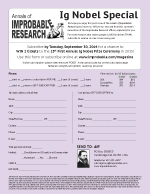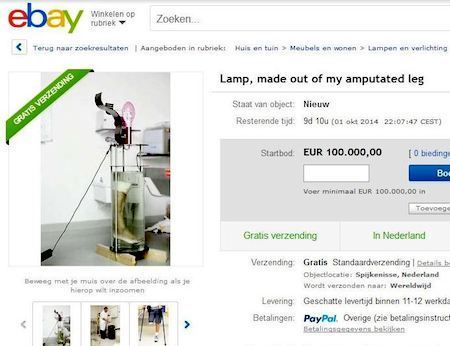Marc Abrahams's Blog, page 374
September 24, 2014
Ig Nobel winner Audoly on the physics of the lasso
Basile Audoly — who shared the 2006 Ig Nobel prize for physics with Sebastien Neukirch for insights into why, when you bend dry spaghetti, it often breaks into more than two pieces — has a new study about the physics of rodeo lassoing. The new paper is:
“An introduction to the mechanics of the lasso,” Pierre-Thomas Brun, Neil Ribe and Basile Audoly, Proceedings of the Royal Society A, vol. 470, no. 2171, November 8, 2014. They write:
“Trick roping evolved from humble origins as a cattle-catching tool into a sport that delights audiences all over the world with its complex patterns or ‘tricks’. Its fundamental tool is the lasso, formed by passing one end of a rope through a small loop (the honda) at the other end. Here, we study the mechanics of the simplest rope trick, the Flat Loop, in which the rope is driven by the steady circular motion of the roper’s hand in a horizontal plane…. In addition to Flat Loops, we find planar ‘coat-hanger’ solutions, and whirling modes in which the loop collapses onto itself. Next, we treat the more general case of a honda that can slide due to a finite coefficient of friction of the rope on itself. Using matched asymptotic expansions, we resolve the shape of the rope in the boundary layer near the honda where the rope’s bending stiffness cannot be neglected. We use this solution to derive a macroscopic criterion for the sliding of the honda in terms of the microscopic Coulomb static friction criterion. Our predictions agree well with rapid-camera observations of a professional trick roper and with laboratory experiments using a ‘robo-cowboy’.”
Here’s a video, prepared by other researchers long ago, about the basics of using a lasso:

Grunts in Conversations
 Conversational Grunts cause serious problems for automatic voice-transcribing algorithms. In fact, as late as year 2000, experts were writing : “… no satisfactory scheme for transcribing these items exists.” The quote is from Nigel Ward, who is currently professor of computer science at The university of Texas at El Paso. The professor has been analysing, cataloguing and generally investigating Conversational Grunts for more than 15 years.
Conversational Grunts cause serious problems for automatic voice-transcribing algorithms. In fact, as late as year 2000, experts were writing : “… no satisfactory scheme for transcribing these items exists.” The quote is from Nigel Ward, who is currently professor of computer science at The university of Texas at El Paso. The professor has been analysing, cataloguing and generally investigating Conversational Grunts for more than 15 years.
Some examples of his grunt-based publications include :
The Relationship between Sound and Meaning in Japanese Back-channel Grunts. (4th Meeting of the (Japanese) Association for Natural Language Processing, 1998.)
Issues in the Transcription of English Conversational Grunts (1st SIGdial Workshop on Discourse and Dialogue. ACL. 2000)
Non-Lexical Conversational Sounds in American English Pragmatics & Cognition 14:1. 2006. 212 pp. (pp. 129–182)
A Model of Conversational Grunts in American English (2002) (IN PAPERS FROM THE 6TH REGIONAL MEETING)
BONUS [1]
A substantial directory of Conversational Grunts, including sound files [in .au format] can be found here via the professor’s website.
BONUS [2]
A glossary of 100 common grunts (from ‘Issues in the Transcription of English Conversational Grunts’)
[clear-throat]
tsk
tsk-naa
tsk-neeu
tsk-ooh
tsk-yeah
[inhale]
[unsticking]
aa
achh
ah
ahh
ai
am
ao
aoo
aum
eah
ehh
h-nmm
haah
hh
hh-aaaah
hhh
hhh-uuuh
hhn
hmm
hmmmmm
hn
hn-hn
huh
i
iiyeah
m-hm
mm
mm-hm
mm-mm
mmm
myeah
nn-hn
nn-nnn
nu
nuuuuu
nyaa-haao
nyeah
o-w
oa
oh
oh-eh
oh-kay
oh-okay
oh-yeah
okay
okay-hh
ooa
ookay
oooh
ooooh
oop-ep-oop
u-kay
u-uh
u-uun
uam
uh
uh-hn
uh-hn-uh-hn
uh-huh
uh-mm
uh-uh
uh-uhmmm
uhh
uhhm
ukay
um
um-hm-uh-hm
umm
ummum
un-hn
unkay
unununu
uu
uum
unmm
uun
uuuh
uuuuuuu
wow
yah-yeah
ye
yeah
yeah-okay
yeah-yeah
yeahaah
yeahh
yegh
yeh-yeah
yei
yo
yyeah
[apologies for any transcription errors, ahem, M.G.]

September 23, 2014
A neutral observer reports on her first Ig Nobel ceremony
What’s it feel like to attend your first Ig Nobel Prize ceremony? You’ll not find a better account than this: Cristine Russell wrote about her night at the Igs, for Scientific American. Russell begins:
Ig Nobel Prizes Make You Laugh, Then Think
By Cristine Russell | September 23, 2014
CAMBRIDGE, Mass.—What happens in the brains of people who see Jesus in a piece of toast? What are the physics of slipping on a banana peel? Are people who see an ugly painting more pain-sensitive than if they see a beautiful one? How do reindeer react to humans disguised as polar bears? Oh, and have you wondered if defecating dogs are sensitive to changes in the Earth’s magnetic fields?
The recent ceremony for the Ig Nobel Prizes at Harvard’s regal Sanders Theatre answered these questions—and many more—in a sold-out spoof in which good-humored scientists made light of their own work and real Nobel laureates wearing silly hats handed out the awards. “Moments of Science” offered goofy on-stage lab experiments; “What’s Eating You,” a three-act mini-opera mocking today’s pill-popping culture, had its world premiere; and, at two designated breaks, the very enthusiastic 1,100-member audience deluged the stage with handmade paper airplanes. Think Monty Python on science steroids.
This intercontinental, if not intergalactic, event—now available on You Tube—is guaranteed to put a smile on even the most serious face and to change the oft-dreary public stereotype of science and scientists.…
Student journalist Ray Wang, too, was attending his first Ig. Wang wrote it up for MIT’s The Tech.
The Amazing Science blogger, also, was a first-time attendee, in the balcony, and wrote and photo-documented the experience.
You can see a few other accounts of the Ig, on our Press Clips page, and a rough overview on the blog item called “Up the nose: Press reports about the Ig Nobel Prizes“.

Further dramatic readings from bizarre studies, Friday night
 We’ll be doing some more Improbable Dramatic Readings — brief public readings from bizarre — yet genuine — scientific studies, this Friday night, September 26, at Porter Square Books, in Cambridge, Massachusetts, starting at 7:00 pm.
We’ll be doing some more Improbable Dramatic Readings — brief public readings from bizarre — yet genuine — scientific studies, this Friday night, September 26, at Porter Square Books, in Cambridge, Massachusetts, starting at 7:00 pm.
The guest readers are:
Robin Abrahams (“Miss Conduct” columnist, and assistant opera director at the Ig Nobel Prize ceremony)
Jean Berko Gleason (Boston University Professor Emerita of Psychology, creator of the Wug Test, and deliverer of the “Welcome, Welcome” speech at the Ig Nobel Prize ceremony)
Gary (pork-up-his-nose) Dryfoos (Majordomo at the Ig Nobel Prize ceremony, and new Internet celebrity and press darling because of his photogenic demonstration, at the recent Ig Nobel Prize ceremony, of how and why doctors stuffed cured pork up a patient’s nose)
The studies are some of the studies I wrote about in my new book This Is Improbable Too.
Here’s video the WGBH Forum Network made of our most recent Improbable Dramatic Readings event. The readers that night were Robin Abrahams, Melissa Franklin (Harvard professor of physics, and frequent Ig Nobel performer), Corky White (Boston University professor of anthropology, and author of Cooking for Crowds and co-author of The Ig Nobel Cookbook, volume 1), and Gus Rancatore (proprietor of Toscanini’s Ice Cream,and co-author of The Ig Nobel Cookbook, volume 1)

Dr. Lindsey Fitzharris explains the clockwork saw
Dr. Lindsey Fitzharris savors the clockwork saw, in this brief video:
(Thanks to Adam Rutherford for bringing this to our attention.)
BONUS: Additional detail, from someone else who saw the saw

The Dilemma-Zone Calculation
Yellow traffic lights posed and provided an opportunity for applied mathematicians. Witness this study, published more than a half century ago:
“The Problem of the Amber Signal Light in Traffic Flow,” Denos Gazis [pictured here, reportedly thrilling an audience], Robert Herman, and Alexei Maradudint, Operations Research, vol. 8, no. 1, 1960, pp. 112-132. The authors, at General Motors Corporation, Warren, Michigan, explain:
“A theoretical analysis and observations of the behavior of motorists confronted by an amber signal light are presented. A discussion is given of the following problem: when confronted with an improperly timed amber light phase a motorist may find himself, at the moment the amber phase commences, in the predicament of being too close to the intersection to stop safely or comfortably and yet too far from it to pass completely through the intersection before the red signal commences. The influence on this problem of the speed of approach to the intersection is analyzed. Criteria are presented for the design of amber signal light phases through whose use such ‘dilemma zones’ can be avoided, in the interest of over-all safety at intersections…
“Many drivers take the attitude that there is nothing sacred about the speed limit!… From [simple calculations] we see that even if the driver is willing to accelerate to speeds greatly in excess of the speed limit, he still cannot eliminate the dilemma zone.”
BONUS: A modern use of that research

September 22, 2014
Win 2 Tickets to the 2015 Ig Nobel Prize Ceremony?
Buy or renew a subscription to our magazine, The Annals of Improbable Research (AIR) by September 30th, and use the special code word when you do, and you will be entered in a drawing for 2 free tickets to the 2015 Ig Nobel Prize Ceremony!
What’s the code word? It’s the theme of this year’s prize ceremony: FOOD.
NOTE: The exact date of the 2015 Ig Nobel Prize Ceremony has not yet been announced – it will be held in Cambridge, MA in September or very early October. There is some additional fine print connected to this promotion. You can find that below.
NOTE ALSO: We hope that, by giving you the code word in this post, we can help you avoid the following sort of situation:
Some Fine Print: No purchase necessary to enter or win. Void where prohibited by law. Entry eligibility begins September 18, 2014 and ends September 30, 2014. Subscriptions using the special paper form or the code word “FOOD” on the online subscription form during the promotion dates are automatically entered. To enter without subscribing to AIR, please print your name and mailing address along with your phone number and/or email address on a 3″x5″ card or facsimile and mail it to Ig Nobel Prize Ceremony Ticket Drawing, Improbable Research, PO Box 380853, Cambridge, MA 02238 USA, postmarked by September 30, 2014. Accompanying limericks welcome, but not required. Winner will be notified by Friday, November 28, 2014, the day Ira Flatow hosts his annual recap of the Ig Nobel Prize Ceremony on public radio’s Science Friday. One set of 2 tickets to the 25th First Annual Ig Nobel Prize Ceremony in 2015 will be awarded; the winner will chosen by random from the entries. Prize value: ~$150. Expenses not specifically included in prize description and all taxes are the sole responsibility of the winner. The exact date of the 2015 ceremony is TBD. Chance of winning depends on the number of entries. One entry per person. This “past & future issues of AIR” promotion is sponsored by Improbable Research, Inc., publisher of the Annals of Improbable Research.

Big Data is, but not unquestioningly, the answer, he says
“Big Data,” a phrase that’s often said aloud with lots of vim (“Big Data!”), is just a heap of junk — until you know what you’re looking for. Jake Porway, writing in the Harvard Business Review, points this out more clearly than many others have:
“We have a lot of data, but we have no idea what we should do with it.” The director of the foundation looked plaintively across the table at me. “We were thinking of having a hackathon, or maybe running an app competition,” he smiled. His co-workers nodded eagerly. I shuddered.
I have this conversation about once a week….
So begins another Improbable Innovation nugget, which appears in its entirety on BetaBoston.

An ethics discussion of the “leg of lamp” medical case
This ethics discussion, broadcast in The Netherlands, concerns the man who lost his leg and gained a floor lamp, which we discussed here recently. Dr. Erwin Kompanje is the main medical discussant here:
UPDATE: The man is trying to sell his leg/lamp on Ebay for 100,000 euros:
Here’s a report about that, by HVNL:

Gluteal Aesthetic Unit Classification
“The idea of an aesthetically pleasing gluteal region has been with us since early recorded history. The ancient Greeks had nomenclature to describe an aesthetically pleasant buttock area: callipygian is derived from calli, meaning beautiful, and pyge, meaning buttocks.”
But, when it comes to surgical buttock re-contouring, not everyone’s idea of callipygia is the same. With this in mind, Dr. Robert F Centeno MD, FACS, MBA has developed a Gluteal Aesthetic Unit Classification, for the first time mapping and defining no less than eight Gluteal Aesthetic Units (pictured) which are, he says, useful for evaluating the gluteal region before undertaking surgical intervention for re-sculpting.
“To achieve a successful outcome, it is imperative to understand the patient’s aesthetic ideal. Toward this end, this simplified ‘Gluteal Aesthetic Unit Classification’ tool can be very useful. Patient-supplied magazine clippings and digital image manipulation are useful in the informed consent process and further support the utility of this classification tool. Finally, to be successful in this arena, it is critical for the surgeon to set aside personal preferences and biases with respect to gluteal aesthetics. What you think looks good may be irrelevant if the patient disagrees.”
See: Gluteal Aesthetic Unit Classification: A Tool to Improve Outcomes in Body Contouring Aesthetic Surgery Journal 2006;26:200-208

Marc Abrahams's Blog
- Marc Abrahams's profile
- 14 followers






